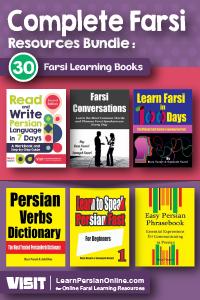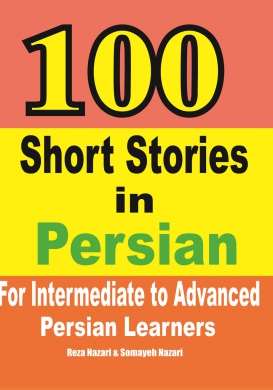
Teaching language to beginners can be a daunting prospect, especially when it’s a monolingual group and you know nothing of their language, or it’s a multilingual group and the only common language is English and you should use English to teach them.
Nevertheless, we think not only is it possible to teach beginners only through English, but it can also be one of the most rewarding levels to teach. To help you succeed in setting your learners firmly on the path to increasing proficiency, here are five tips for teaching Persian to beginners.
Best Farsi Learning Resource!
1. Give them Persian versions of their favorite books

If reading in Persian is something your students see as a chore, an easy way to make it more fun for them is to give them their favorite books in Persian. A remarkable number of popular books have been translated, and it may well be that their favorite book was actually written in Persian originally.
Reading their favorites in Persian doesn’t just mean that they’re going to be more interested in the story; it also makes the act of reading in a foreign language much more effortless. It means that if there’s some Persian vocabulary that they don’t understand, they won’t need to keep running for the dictionary – they’ll be more easily able to find it out from context.
Reading a book in a new foreign language can be frustrating, especially if a misunderstanding leads you to lose the main thread of the plot, but actually, when it’s a book that you already know well, it becomes a lot more painless for you. It’s even better if they then get hooked on reading a series that was originally in Persian – in fact, reading in a foreign language might seem like a reasonable exchange for getting to read the book before it appears in translation.
2. Let them listen first

More than likely, your students will want to start practicing speaking Persian pretty much from the get-go. However, it takes a while for one’s ear to acclimatize to the sounds of a new foreign language, and not everyone will be so keen; please don’t pressure your students into speaking before they’ve had lots of opportunity to listen to you using it (which doesn’t mean you should just be rambling on at the front of your classroom – with beginners more so than with other levels, s you know, you really have to consider what you say and grade your language accordingly).
3. Do easy tasks in Persian and use Persian for straightforward things

Requiring your students to talk to you in Persian at set times – such as in the last 30 minutes of class – is a popular tip, but that can feel stressful for your students, both in terms of the pressure to do well and the frustration if they struggle to express themselves fully. At earlier learning stages, maybe they don’t have enough vocabulary to respond properly, so they end up following a textbook conversation rather than communicating meaningfully. That’s exactly the opposite of making learning a language fun.
What you can do that’s much lower pressure is to use Persian for really straightforward things. For example, basic instructions that don’t require a response, or only need a yes or no answer, can be communicated in Persian. That’s things like «I want to teach you 5 new Persian words, are you agree?» or «Did you like this lesson?» – statements that use introductory Persian vocabulary and therefore can easily be understood. That way, they’re still listening to Persian being spoken and therefore learning, but it’s not going to be hard work for them.
Think about it like practicing driving: in fact, you wouldn’t take them on the motorway and insist they manage, but you might let them practice by driving you down quiet roads to the cinema or shops.
Once they’ve gained a little more vocabulary, you can try out doing straightforward tasks in Persian as well, such as playing some games in class. These tasks involve a relatively limited range of Persian vocabulary that you could get into the habit of saying in Persian, and your students could respond to you in Persian or in their native language as suits them best.
Our courses:
- Beginners Complete Persian Course
- Intermediate Complete Persian Course
- Advanced Complete Persian Course
4. Drill, repeat, drill, repeat, drill…

Beginner learners need lots of repetition and drilling, especially as they get to grips with the sounds of their new language. We know, it might seem boring to go over the same sentences again and again, but it is necessary. When practicing a new sentence, try back-drilling, please break the sentence down into manageable units and then build it back up, you have to work backward from the end of the sentence to the beginning; this will help to ensure that your intonation is natural and that you get elements of connected speech right.
Here is an English example, break down «Would you like a cup of coffee?» as follows:
coffee > cup of coffee > like a > like a cup of coffee > Would you > Would you like a cup of coffee?
5. Please don’t forget that your students are fluent in their own language(s)

Maybe this seems a trivial point, but it’s all too easy when listening to somebody speaking broken Persian to forget that behind the errors and the mispronunciation is a person with cogent and unique thoughts, no doubt articulate in their mother tongue, attempting to communicate his or her opinions or ideas.
As Persian teachers, we not only have to be patient and proactive listeners, rather, we should even help our students to continue speaking Farsi and also encourage them. We have to grade their language skills carefully so as to keep them comprehensible while maintaining their naturalness, rhythm, and spirit, ensuring all the while that, as far as possible, we actually converse with our learners and listen to what they have to say. Don’t forget, even from the very first lessons, from the ‘الف’ in the alphabet, communication is the goal.
Best Farsi Learning Resource!
by: Learn Persian Online Team about (category: Blog)













What people say about "5 Engaging Tips to Make Your Students Love and Learn Persian"?
No one replied yet.